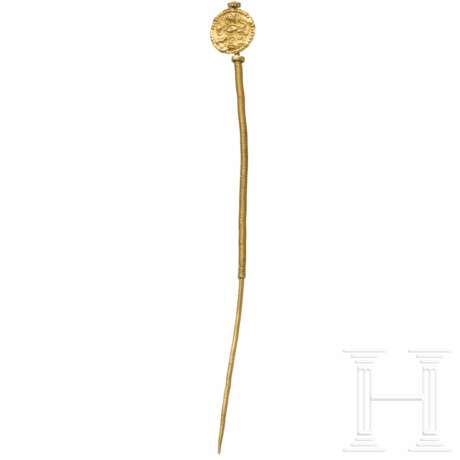ID 832802
Lot 60 | Goldnadel mit Mysteriensymbolen gegen den bösen Blick, römisch, 2. - 3. Jhdt.
Estimate value
€ 2 000
Die von hinten über einem Modell getriebene Darstellung der Pressblechscheibe stellt in der Mitte ein Auge dar, das den bösen Blick symbolisiert. Ringsherum diverse Mysteriensymbole, wie sie aus orientalischen Kulten, u.a. dem Mithraskult oder auch dem Donaureiterkult, bekannt sind. Diese teils deutlich gegen den "bösen Blick" gewandt und ihn in Schach haltend. Zu den Symbolen zählen ein Blitzbündel, ein Skorpion, ein Löwe, eine Schlange, ein Hahn und ein Tausendfüßler sowie ein Dolch und ein Pfeil. Länge 14,3 cm. Gewicht 8,12 g.
Eng verwandte Darstellungen stammen u.a. von einzeln gefundenen römischen Amuletten, teils ebenfalls aus Gold, sowie anderen Kunstgattungen wie Mosaiken, Wandmalereien oder Öllampen. Die vorliegende Nadel mit einem integrierten Amulett als Schutzzauber gegen den bösen Blick darf als ein selten schönes und nahezu perfekt erhaltenes Exemplar dieses Motivs auf einem kunsthandwerklichen Kleinobjekt gelten. Sie ist ein spannendes religionsgeschichtliches Zeugnis für das Eindringen orientalischer Kulte mit dualistischen Vorstellungen ins römische Reich, bei denen der ewige Kampf zwischen Gut und Böse symbolisiert ist, den dem Licht bzw. der Sonne zugeordnete Gottheiten wie z.B. Mithras führen. Vergleichbare Denkmäler zuletzt systematisch besprochen von Rita Chinelli (Fundort Wien, Beiträge zur Archäologie, 13/2010).
Provenienz: Süddeutsche Privatsammlung.
Goldene Nadel, oben mit einem Kopf aus einer zylindrischen Manschette um die Nadel versehen, die außen mit zwei horizontalen Reihen von Granalien geschmückt ist. Darunter eine goldene Pressblechscheibe mit Mysteriensymbolen rund um ein Auge, die auf der Rückseite mit zwei Manschetten beweglich um die Nadel befestigt ist. Unterhalb der Pressblechscheibe nochmals eine massive bewegliche Manschette, die von einer 7,8 cm langen Umwicklung der Nadel aus feinem Golddraht gehalten wird. Darunter läuft die blanke Nadel mit einer verbleibenden Länge von 5,5 cm in eine stumpfe Spitze aus.
Die von hinten über einem Modell getriebene Darstellung der Pressblechscheibe stellt in der Mitte ein Auge dar, das den bösen Blick symbolisiert. Ringsherum diverse Mysteriensymbole, wie sie aus orientalischen Kulten, u.a. dem Mithraskult oder auch dem Donaureiterkult, bekannt sind. Diese teils deutlich gegen den "bösen Blick" gewandt und ihn in Schach haltend. Zu den Symbolen zählen ein Blitzbündel, ein Skorpion, ein Löwe, eine Schlange, ein Hahn und ein Tausendfüßler sowie ein Dolch und ein Pfeil. Länge 14,3 cm. Gewicht 8,12 g.
Eng verwandte Darstellungen stammen u.a. von einzeln gefundenen römischen Amuletten, teils ebenfalls aus Gold, sowie anderen Kunstgattungen wie Mosaiken, Wandmalereien oder Öllampen. Die vorliegende Nadel mit einem integrierten Amulett als Schutzzauber gegen den bösen Blick darf als ein selten schönes und nahezu perfekt erhaltenes Exemplar dieses Motivs auf einem kunsthandwerklichen Kleinobjekt gelten. Sie ist ein spannendes religionsgeschichtliches Zeugnis für das Eindringen orientalischer Kulte mit dualistischen Vorstellungen ins römische Reich, bei denen der ewige Kampf zwischen Gut und Böse symbolisiert ist, den dem Licht bzw. der Sonne zugeordnete Gottheiten wie z.B. Mithras führen. Vergleichbare Denkmäler zuletzt systematisch besprochen von Rita Chinelli (Fundort Wien, Beiträge zur Archäologie, 13/2010).
Provenance: Southern German private collection.
| Place of origin: | Roman Empire |
|---|
| Place of origin: | Roman Empire |
|---|
| Address of auction |
Hermann Historica Bretonischer Ring 3 85630 Grasbrunn / München Germany | ||||||||||||||
|---|---|---|---|---|---|---|---|---|---|---|---|---|---|---|---|
| Preview |
| ||||||||||||||
| Phone | +49 (0)89 5472 649 0 | ||||||||||||||
| Fax | +49 (0)89 5472 64999 | ||||||||||||||
| Buyer Premium | 25 % | ||||||||||||||
| Conditions of purchase | Conditions of purchase | ||||||||||||||
| Business hours | Business hours
|



